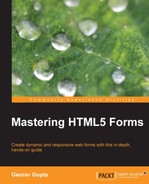Web viewers may never know about the background of an application, such as HTML5, CSS3, Responsive Web Design, or PHP. What they want to know is whether your application works on their device or not and how much effort is required.
Even though web development has changed over the years, the core task of creating a web page has not been changed. We create a document and put it out on the Web for people to view. To put something on the Web, we need to learn some special languages that are accepted on the Web. Yes, we are talking about the scripting languages such as HTML and PHP.
The main objective of this book is to ensure that the user who fills the form built by you should enjoy and feel satisfied in every possible way. Here, satisfaction means the look and feel of the forms and minimum adjustments on the page while navigating, which can be on a desktop computer, mobile device, or mini laptop.
This book has been written keeping in mind that readers should enjoy a step-by-step, example driven, and visual-based approach to learning. This book will cover many aspects of web development, such as the language used to develop the web forms as well as ways to make web forms look good and accept information from visitors.
This book will act as a platform with which you will learn how to create beautiful and responsive forms and link them to the database where the form information will be stored.
Chapter 1, Forms and Their Significance, explains what web forms are and how we can create these using the new HTML5 form elements. It also explains the benefits of web forms along with the guidelines that must always be kept in mind while designing and developing a form.
Chapter 2, Validations of Forms, explains validations and their necessity in forms as well as the new HTML5 elements and their attributes that reduce the effort of client-side validations. It gives a brief description of the validation constraints and supported API's and also briefs us on the customization of error messages on the browser.
Chapter 3, Styling the Forms, explains the CSS3 properties that can be utilized to make forms more presentable. It details us about the vendor-specific prefixes that are utilized in different browsers along with the effective styling guidelines that must be kept in mind while enhancing the look and feel of a form.
Chapter 4, Connection with Database, explains briefly about linking a form to the server using PHP and MySQL, which are used by web developers to store user information.
Chapter 5, Responsive Web Forms, explains responsive designing and approaches that can be used to make our form responsive. It also discusses the guidelines you should follow to make a responsive form.
